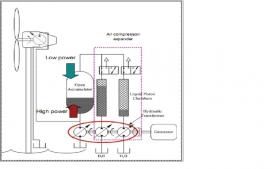Compressed Air Open Accumulator Increases Wind Power Energy Storage
A fluid power-based approach to wind energy storage is now in development based on an open accumulator energy storage concept previously developed at the Center for Compact and Efficient Fluid Power (CCEFP), an NSF-funded Engineering Research Center (ERC) headquartered at the University of Minnesota. Two companies have already licensed the open accumulator energy storage technology and are working to commercialize it.
Because wind is intermittent and unpredictable, the ability to store wind power can significantly increase its usefulness. However, storing large amounts of energy as several megawatt-hours (MWh) economically, efficiently and with the capability of high conversion rates is a challenge.
The open accumulator developed by CCEFP stores excess wind energy as high-pressure compressed air. When power demand exceeds available wind power, the compressed air can be released to generate electricity. Power output from the wind turbine becomes more predictable and energy that would otherwise be wasted is captured. Because energy storage occurs prior to the generation of electricity, many electrical components can also be downsized, minimizing the cost of wind power generation.
CCEFP’s unique wind energy storage system is currently capable of producing enough high energy density to store 24 MWh of energy in a 500 cubic meter (m3) volume. The open accumulator concept uses the high power density of hydraulics (liquid fluid power) and the high energy density of pneumatics (gas fluid power) in a single architecture. By enhancing heat transfer inside the air compressor/ expander, a near isothermal process is achieved to attain high efficiency. This architecture allows the system to operate at near constant pressure, regardless of the energy content, so that efficiency and power capability can be maintained at all times.
A four-year, $2 million research grant from the NSF’s Engineering Frontiers for Research and Innovation (EFRI) program funded the additional research and development required to enable the mature, commercial application.


